Isn’t it weird when television shows change actors playing characters midway through a series? Especially after you have come to know and love the actor as that character?
In the history of TV, this type of swap is more common than you think, with at least 200 instances of existing characters being recast. Taking soap operas into account, that number grows nearly exponentially: in just the nine largest American soap operas there have been more than 600 instances of characters being recast (a majority of those many times).
Recasting might be required simply due to a character becoming important later in a series or to actors leaving to pursue other roles. In some cases, actors were pushed out due to labor disputes, personality clashes, or, rarely, bad breakups between co-stars. Very rarely, recasting is due to an untimely death.
Regardless of why it happens, it’s always a bit of an odd situation: viewers don’t forget who used to play the role, but they do get used to the new actor. If those in charge of casting are good at their jobs, viewers probably go on to love the new actor just as much.
These new actors might play the roles differently, but viewers will probably still like their new takes on them. This does not necessarily apply to “Doctor Who,” but that is a discussion all to itself.
Television series with recast characters take on different lives, and there will always be fans preferring one over the other. I like to look at them in a differentiated manner, as two versions of a good thing. If I already loved a show, why would different actors make a huge difference? It’s the same as having a half pepperoni, half Margherita pizza: they are just two styles of a delicious food, both still pizza.
The same can apply to long-running brand partnerships in the watch industry: sometimes partnerships change, and the new partnership, while different, is awesome in its own way. You may be sad that one collaboration ended, but you are also excited about what may come from the new relationship.
After Aston Martin changed watch partners in early 2017, going from Jaeger-LeCoultre to Richard Mille, Lamborghini finished its partnership with Blancpain (I quietly hum “I Will Remember You” à la Sarah McLachlan) to begin a new partnership with Roger Dubuis.
While looking back over the memories, I snap back into the present with the first collaborative piece between Lamborghini and Roger Dubuis: the brand new Excalibur Aventador S. The product of a joint effort between engineers and designers at Centro Stile (Lamborghini’s design studio) and Roger Dubuis, the Excalibur Aventador S paves the way to the new partnership with an entirely new movement.
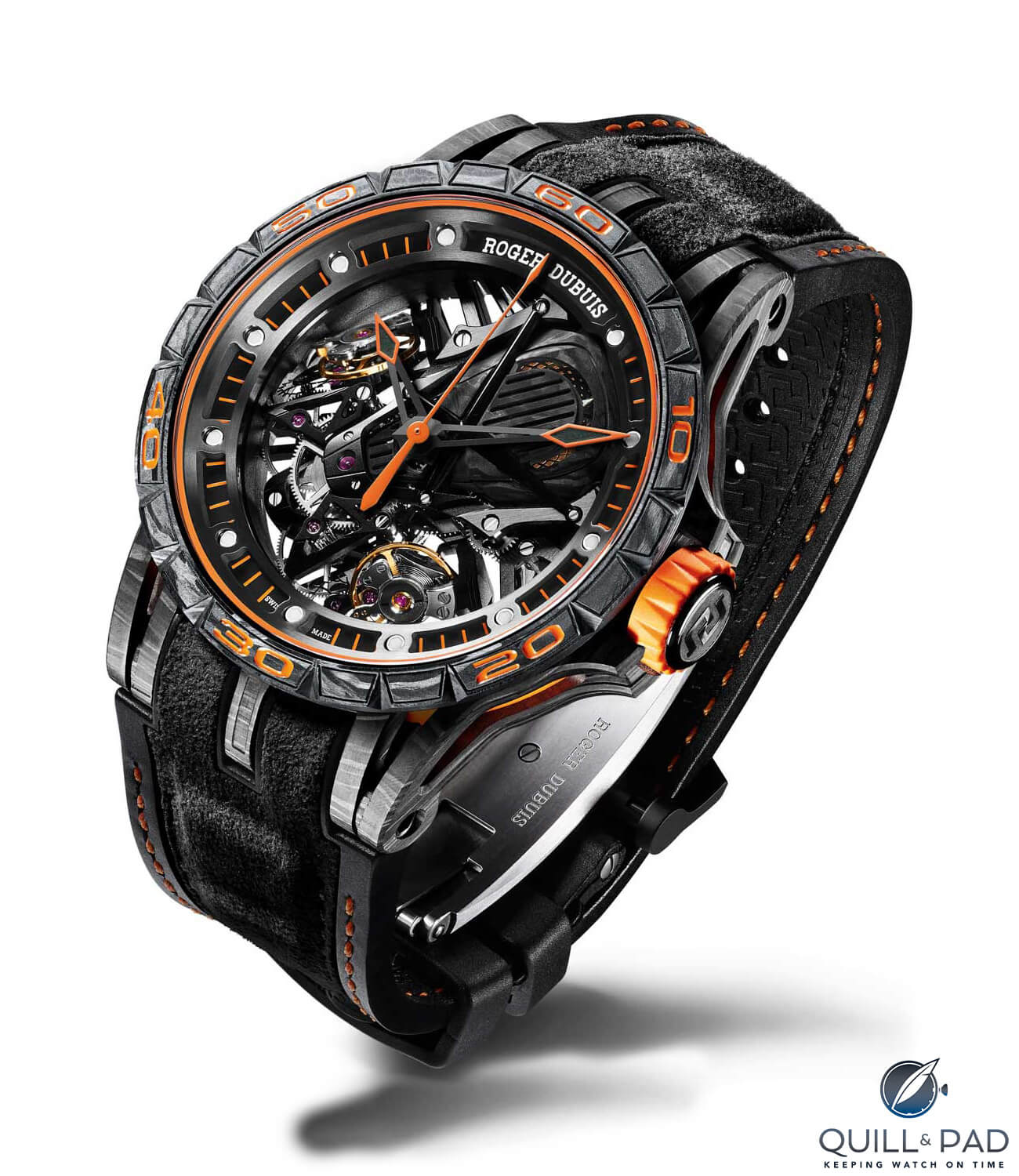
Roger Dubuis Excalibur Aventador S with orange trim
Surprise, surprise
The announcement of the new partnership between Roger Dubuis and Lamborghini may have come as a surprise (I, for one, was not aware the relationship with Blancpain was ending), but the release of the Excalibur Aventador S was the bigger news thanks to the all-new RD103SQ caliber powering it. Called the Duotor, the RD103SQ features two balance wheels connected via a center differential slanted 45 degrees from vertical, resulting in axes of rotation that are perpendicular to each other.
The Duotor is descended from the Quatuor, the four-balance movement debuted in 2013, but it utilizes only two balances and one differential, opting to add other complications and focusing on movement architecture.
The same principles apply to the RD103SQ and its twin four-Hertz balances, though using two oscillators mechanically linked to average out errors from gravity, position, and shocks to provide a more consistent rate. I was always intrigued by the Quatuor movement, but I find this dual-balance implementation to be much more appealing to the eye.
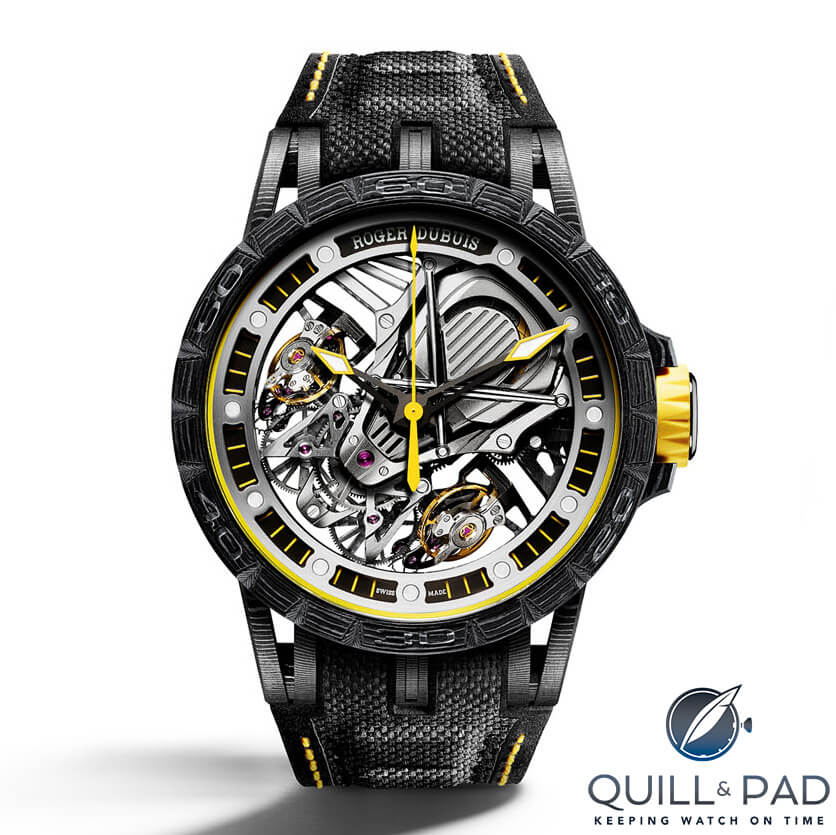
Roger Dubuis Excalibur Aventador S
The entire movement is rotated 45 degrees from square in the case, which means the two balances fly alongside the center body at 5 and 10 o’clock. The differential between 7 and 8 o’clock combines the 4 Hz frequencies of each balance for an averaged 8 Hz before the energy is transferred to the jumping seconds mechanism.
More mechanical creativity
Oh, yes, the RD103SQ features a jumping seconds function, a first for the brand. While this may seem like a strange feature in an automotive-inspired watch like this, it actually came about in response to the Quatuor. That watch boasted four balances linked by a series of differentials in an attempt to provide an extremely consistent rate, yet lacked a second hand entirely. Following customer feedback and some self-assessment, it was decided that a jumping second hand made the most sense to highlight the improved accuracy of such a movement.
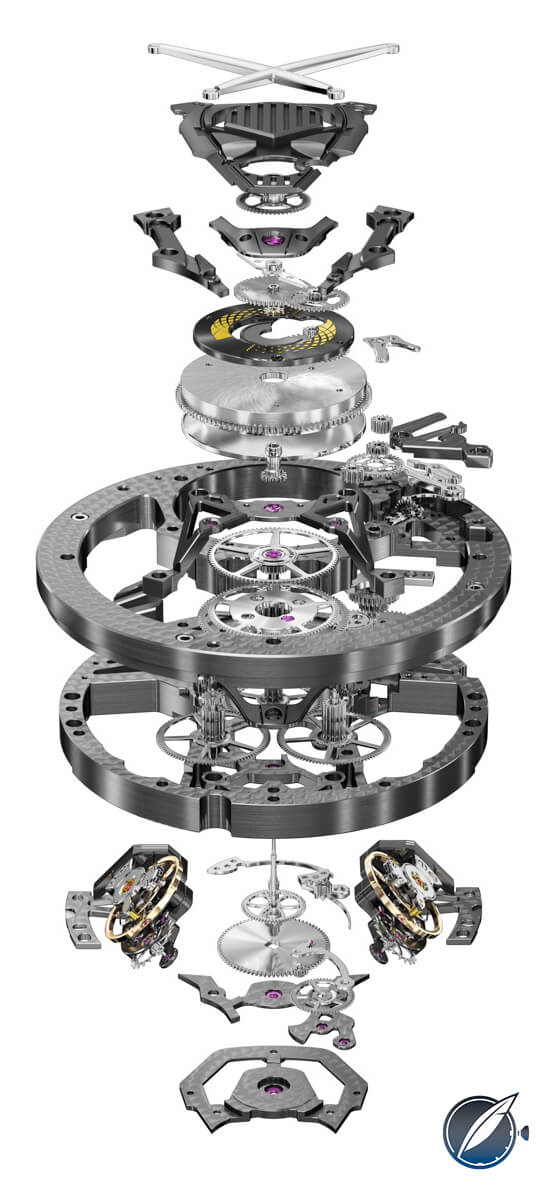
Exploded view of Caliber RD103SQ, which powers the Roger Dubuis Excalibur Aventador S
The center second hand ticks off each consistent second individually and allows the accuracy of the movement to be seen and traced over time. The movement does not have hacking seconds however, so extremely precise setting still is an elusive goal, but that is largely beside the point for a timepiece like this.
On the other side of the jumping seconds we come to the spring barrel and power reserve mechanism. What would usually be a fairly standard feature for a manual-wind watch, the entirety of the movement was designed so that each element fit an overall aesthetic goal of recreating (in a way) the engine bay of the Lamborghini Aventador. One look at the sizable X-brace and the grooved “valve cover” covering the mainspring lets you know the goal was a successful one.
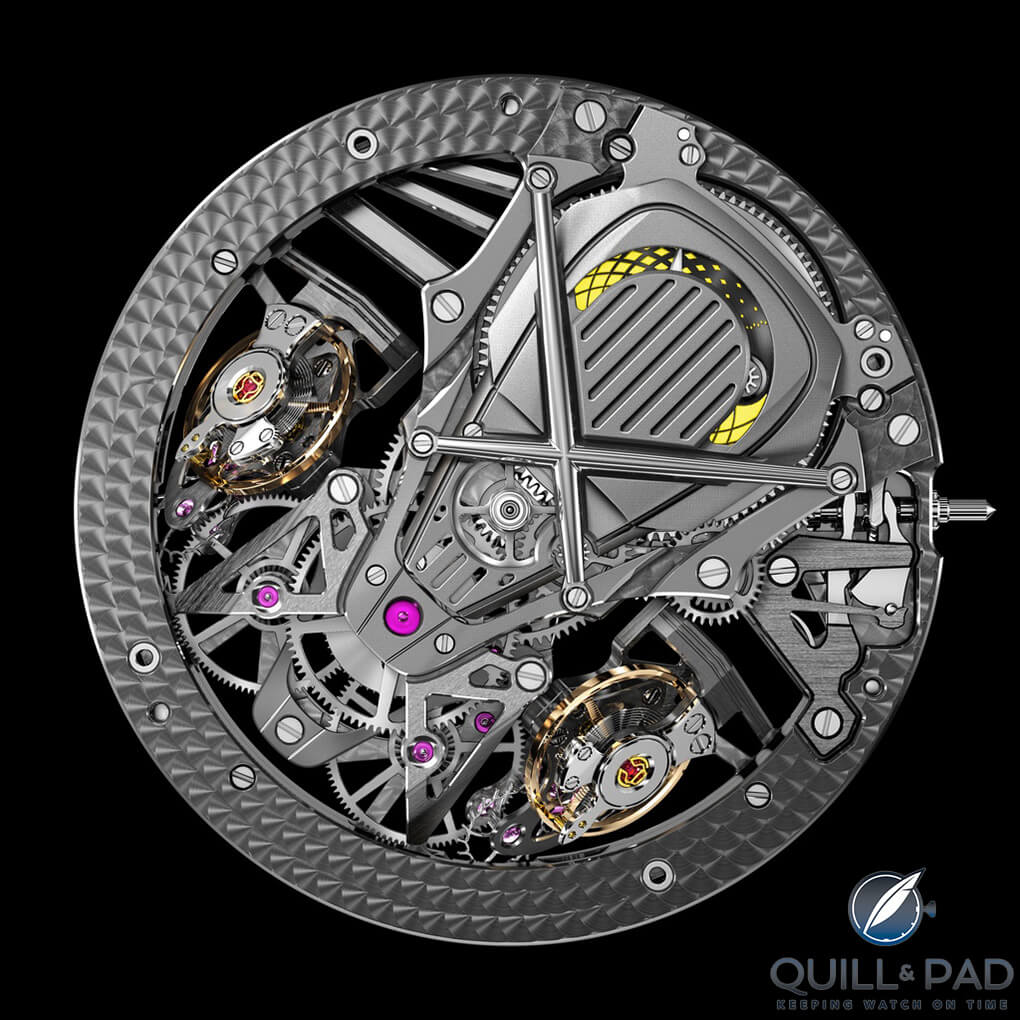
Roger Dubuis Excalibur Aventador S Caliber RD103SQ
Aside from the twin balances on wings to the side, the majority of the movement is organized inside of an engine-esque form factor. The way the bridges and plates are shaped clearly draws to mind the engine bay of a supercar. It also brings to mind images of a scarab beetle or spider, but that is just due to the overall skeleton shape.
The X-brace spans the bridges that support the differential, jumping second mechanism, and spring barrel, resting in a cutout of the top “engine” cover. This cover (and the case) is probably the biggest difference between the two versions of the Excalibur Aventador S, as in one version it is made by Lamborghini in its own carbon production facility.

A close look dial side at the opposed balance wheels on the Roger Dubuis Excalibur Aventador S
The two versions differentiate mainly in highlight colors and movement finishing treatments. The 88–piece limited edition utilizes yellow highlights and features polished, brushed, and satin-finished anthracite grey NAC coatings.
The eight-piece edition uses orange highlights and finds much of the movement blacked out with the same styles of finishing. The cover over the mainspring is made of forged C-SMC carbon from Lamborghini, the same material also used in the case of this version.

Roger Dubuis Excalibur Aventador S in its case

View through the display back of the Roger Dubuis Excalibur Aventador S
The two different types of carbon – the layered carbon in the 88-piece edition and the forged variety of the eight-piece edition – are similar in idea, but very different in execution. Visually, the difference between a layered and a random/amorphous carbon pattern can make a huge difference to the perception of the watch. The layered carbon version with yellow highlights feels lighter and gives a sense of speed while the orange forged version feels more robust and animalistic. The difference isn’t huge, but it is definitely noticeable.
No matter which version you prefer, the real reason for the excitement comes down to the movement, this wonderful, interesting, creative new movement. Like all Roger Dubuis movements, it is stamped with the legendary Geneva Seal, meaning that even the carbon components are finished in such a way as to exemplify haute horlogerie.
Given the history behind Roger Dubuis and the development of stellar avant-garde timepieces and the raw excitement of Lamborghini, the combination works well. The Excalibur Aventador S in either version is a solid beginning to a new partnership.
I may daydream about the days gone by with Blancpain and Lamborghini at the Super Trofeo (see You Are There: Blancpain Lamborghini Super Trofeo World Finals At Sebring), but the next chapter for Lamborghini has begun with a recasting in the role of “partner.”
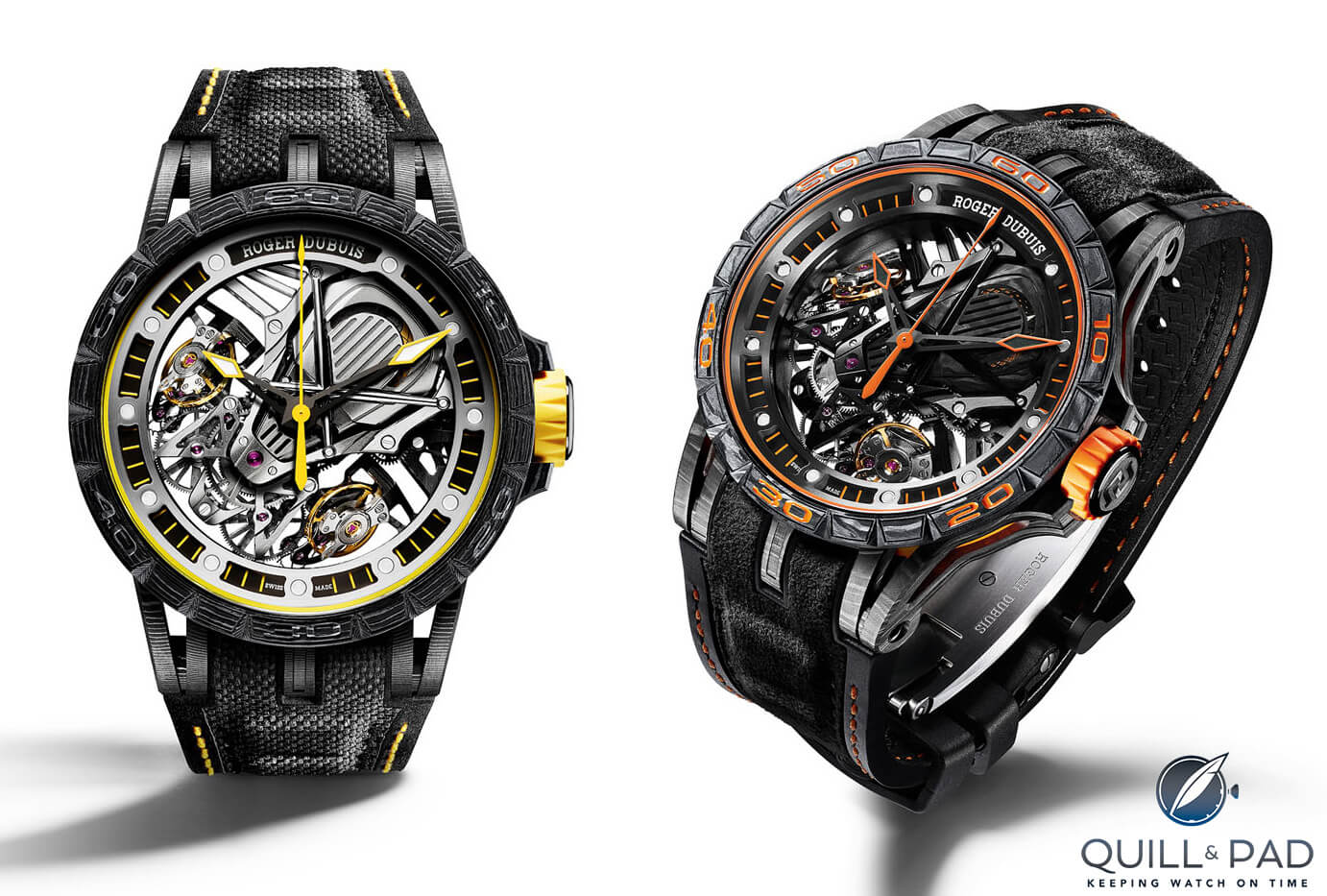
Roger Dubuis Excalibur Aventador S in yellow and orange
What came before was great, but based on the Excalibur Aventador S, what may come next will probably be pretty awesome in its own way. Now the only thing left to do is wait patiently for some wrist time!
Until then, I better break it all down!
- Wowza Factor * 9.6 Disregarding the fact of the new partnership with Lamborghini (that’s a whole other thing entirely), the Excalibur Aventador S wows in more ways than one!
- Late Night Lust Appeal * 96.0 » 941.438m/s2 The Excalibur Aventador S has kept me up many a night lusting over that dual-balance, jumping-seconds engine inside!
- M.G.R. * 68.9 The RD103SQ is one very serious movement, with style and pizzazz that gets this new relationship with Lamborghini off to a bang!
- Added-Functionitis * Mild The big debate over movements like these is whether you count the jumping seconds as an added function. I’ll go the “well, technically” route and say it isn’t a complication and therefore the power reserve is the only added feature. Still, you will need to use some children’s strength Gotta-HAVE-That cream for surprisingly complicated swelling!
- Ouch Outline * 12.1 Grabbing a hot pan with your bare hands! This hasn’t happened to me in years, but the memory of it is still fresh in my mind. Yet if it meant getting one of these bad boys for my wrist, I would gladly grab that imaginary hot frying pan and take one for the team!
- Mermaid Moment * 2.6 seconds! That’s around the time it takes for the Lamborghini Aventador S to go 0-60 mph – and around the same time it takes to realize you better find a reverend to oversee the ceremony!
- Awesome Total * 762 Multiply the diameter of the case in millimeters (45) with the water resistance in bar (5), then multiply by the number of balances in the RD103SQ (2), finally add the total number of components in the movement (312) for a rip-roaringly fast and awesome total!
You may also be interested in reading about the new car introduced at the same time in Lamborghini Huracán Super Trofeo EVO: The Car Behind The Watch.
For more information, please visit www.rogerdubuis.com/watches/excalibur/excalibur-aventador-s.
Quick Facts Roger Dubuis Excalibur Aventador S
Case: 45 x 14.05 mm, layered carbon fiber and titanium or C-SMC carbon and titanium
Movement: manual winding Caliber RD103SQ
Functions: hours, minutes, jumping seconds; power reserve
Limitation: 88 pieces in yellow layered carbon, 8 pieces in orange C-SMC carbon
Price: $185,000 (yellow 88 piece edition); $205,000 (orange 8 piece edition)

Trackbacks & Pingbacks
[…] only recently announced its partnership with Roger Dubuis, which delighted us with the tantalizing Excalibur Aventador S described so eloquently by my colleague Joshua […]
[…] SIHH continue with one each for the Lamborghini and Pirelli lines, docking seamlessly into 2017’s Aventador S […]
[…] Roger Dubuis recently announced their new partnership, our eyes were of course fully focused on the Roger Dubuis Excalibur Aventador S featuring the Duotor […]
Leave a Reply
Want to join the discussion?Feel free to contribute!